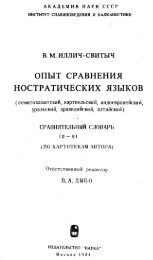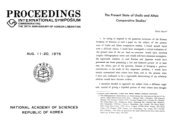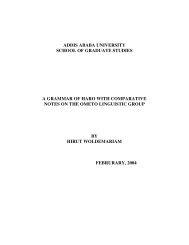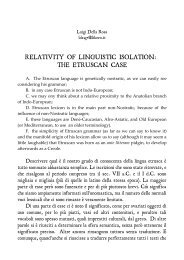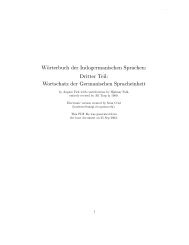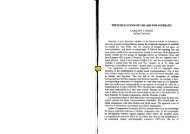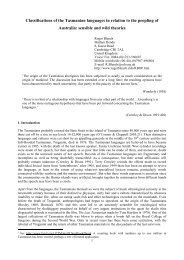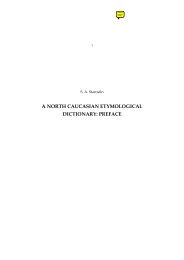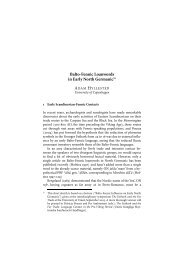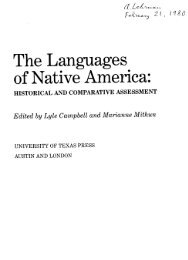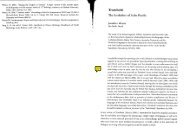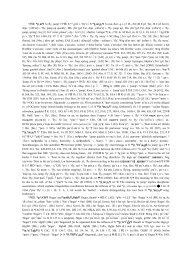The Indo-European Elements in Hurrian
The Indo-European Elements in Hurrian
The Indo-European Elements in Hurrian
Create successful ePaper yourself
Turn your PDF publications into a flip-book with our unique Google optimized e-Paper software.
150 9. Before Proto-<strong>Indo</strong>-<strong>European</strong> and <strong>Hurrian</strong><br />
correspond to pla<strong>in</strong> voiced stops <strong>in</strong> <strong>Hurrian</strong>. Even with<strong>in</strong> <strong>Indo</strong>-<strong>European</strong>, these two series have<br />
the same reflexes <strong>in</strong> several of the daughter languages. Moreover, the reconstruction of voiced<br />
aspirates is only needed to account for the developments <strong>in</strong> certa<strong>in</strong> branches (<strong>Indo</strong>-Iranian,<br />
Greek, Armenian, and Italic). F<strong>in</strong>ally, there is noth<strong>in</strong>g <strong>in</strong> the Anatolian <strong>Indo</strong>-<strong>European</strong> daughter<br />
languages to <strong>in</strong>dicate that the voiced aspirates of traditional grammar were anyth<strong>in</strong>g other than<br />
pla<strong>in</strong> voiced stops. And yet, when the entire corpus of comparative data from the <strong>Indo</strong>-<strong>European</strong><br />
daughter languages is taken <strong>in</strong>to consideration, it is clear that it is still necessary to posit two<br />
separate series here at the level of the <strong>Indo</strong>-<strong>European</strong> parent language, as well as a third series,<br />
the traditional pla<strong>in</strong> voiceless stops.<br />
One solution is to see the traditional voiced aspirates as later developments with<strong>in</strong> Proto-<br />
<strong>Indo</strong>-<strong>European</strong> and to re<strong>in</strong>terpret them as pla<strong>in</strong> voiced stops. This then makes it necessary to<br />
<strong>in</strong>terpret the traditional pla<strong>in</strong> voiced stops as someth<strong>in</strong>g else <strong>in</strong> order to ma<strong>in</strong>ta<strong>in</strong> the dist<strong>in</strong>ction<br />
between the two series. Proposals <strong>in</strong>clude see<strong>in</strong>g the traditional pla<strong>in</strong> voiced stops as glottalized<br />
stops (ejectives) or as pla<strong>in</strong> (unaspirated) voiceless stops. Under both these proposals, the<br />
traditional pla<strong>in</strong> voiceless stops are then re<strong>in</strong>terpreted as voiceless aspirated stops. Lehmann<br />
(2002:201) opts for the first alternative — glottalized stops. Unfortunately, <strong>Hurrian</strong> adds noth<strong>in</strong>g<br />
to the solution. This leads us to the question of what must be reconstructed to account for both<br />
the <strong>Hurrian</strong> and <strong>Indo</strong>-<strong>European</strong> developments. Clearly, the traditional pla<strong>in</strong> voiced stops and<br />
voiced aspirates represent two dist<strong>in</strong>ct series <strong>in</strong> Proto-<strong>Indo</strong>-<strong>European</strong>, the <strong>Hurrian</strong> corresponddences<br />
notwithstand<strong>in</strong>g. Thus, we suggest the follow<strong>in</strong>g <strong>in</strong>terpretation: (1) the traditional<br />
voiced aspirates (*bh, *dh, *gh) of <strong>Indo</strong>-<strong>European</strong> grammar are to be derived from earlier pla<strong>in</strong><br />
voiced stops (*b, *d, *g), (2) the traditional pla<strong>in</strong> voiced stops (*b, *d, *g) from glottalized stops<br />
(ejectives) (*p’, *t’, *k’), and (3) the traditional voiceless stops (*p, *t, *k) from voiceless<br />
aspirates (*pº, *tº, *kº) — the aspiration was non-phonemic and will not be written <strong>in</strong> what<br />
follows. Accord<strong>in</strong>gly, we get:<br />
Pre-<strong>Hurrian</strong> /<br />
Traditional<br />
<strong>Indo</strong>-<strong>European</strong> <strong>Hurrian</strong> Proto-<strong>Indo</strong>-<strong>European</strong><br />
Labial: Voiceless p p p<br />
Glottalized p’ b b<br />
Voiced b b bh<br />
Dental: Voiceless t t t<br />
Glottalized t’ d d<br />
Voiced d d dh<br />
Velar: Voiceless k k $/k<br />
Glottalized k’ g ĝ/g<br />
Voiced g g ĝh/gh<br />
Labiovelar: Voiceless k¦ ku k¦<br />
Glottalized k’¦ gu g¦<br />
Voiced g¦ gu g¦h<br />
Note: <strong>The</strong> phoneme traditionally reconstructed as *b was extremely rare <strong>in</strong> Proto-<strong>Indo</strong>-<br />
<strong>European</strong>, and some have questioned whether it even existed at all.



